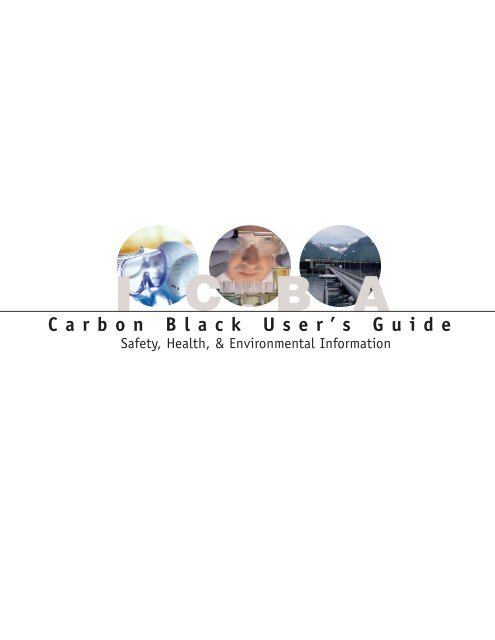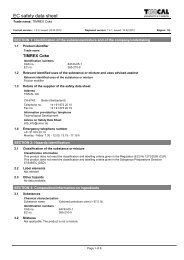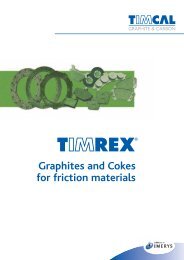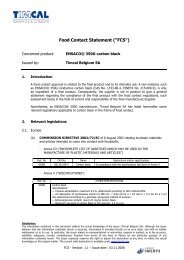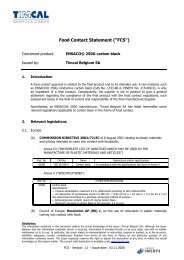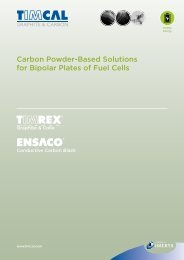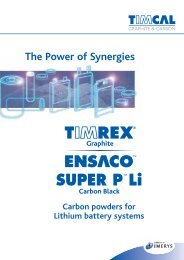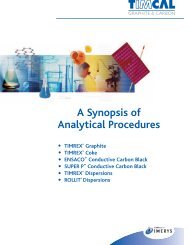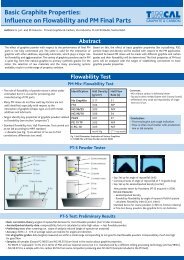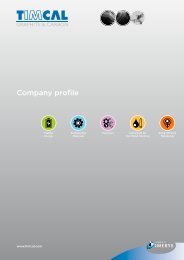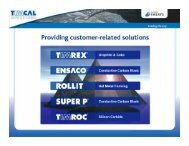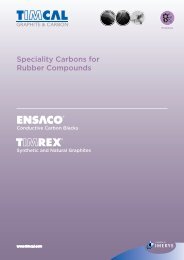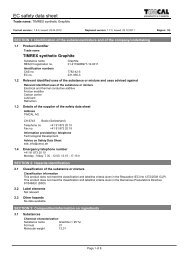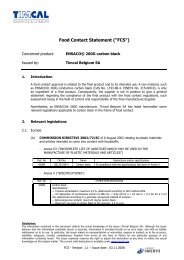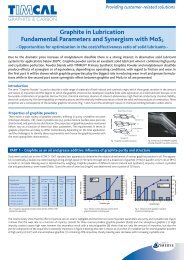Carbon Black Users Guide - Timcal
Carbon Black Users Guide - Timcal
Carbon Black Users Guide - Timcal
You also want an ePaper? Increase the reach of your titles
YUMPU automatically turns print PDFs into web optimized ePapers that Google loves.
I C B A<strong>Carbon</strong> <strong>Black</strong> User’s <strong>Guide</strong>Safety, Health, & Environmental Information
IMPORTANT NOTEThis booklet is not a Material Safety Data Sheet (MSDS),nor is it intended to serve as an MSDS substitute. Pleasemaintain and review the most current MSDS, availablethrough your carbon black supplier, prior to workingwith this product.
PurposeThis guide summarizes essential health, safety,and environmental information for operationaldesign, maintenance, training, emergencyresponse and handling practices that may beassociated with the use of carbon black. Theinformation contained herein is provided tosupplement the knowledge of trained andqualified users of carbon black.This publication represents the currentknowledge of the International <strong>Carbon</strong> <strong>Black</strong>Association (ICBA) members as of the date ofpublication. <strong>Users</strong> should remain informed onnew developments and information aboutcarbon black properties, handlingtechnology and regulatory requirements thatoccur following the publication date. Anyquestions should be addressed to your carbonblack supplier.
ContentsGENERAL INFORMATION 1What is <strong>Carbon</strong> <strong>Black</strong>? 1How is it Produced? 1<strong>Carbon</strong> <strong>Black</strong>, Soot, and <strong>Black</strong> <strong>Carbon</strong> 2Other Particle Size Characteristics 3SAFETY 4Fire and Explosion 4Storage and Handling 4Confined Space Entry 4Housekeeping 4Acute First Aid 5HEALTH 5Overview 5Human Studies 5Animal Studies 6Carcinogenicity 6Mutagenicity 7Reproductive Effects 7Chronic Ingestion 7Eye Contact 7Skin Contact 7Sensitization 7<strong>Carbon</strong> <strong>Black</strong> in Materialsin Contact with Foodstuffs 7Animal Irritant Tests 7OCCUPATIONAL HYGIENE 7Overview 7Exposure Assessment 8<strong>Carbon</strong> <strong>Black</strong> Dust Monitoring 8Engineering Exposure Controls 8Respiratory Protection 8Occupational Exposure Limits 9Medical Surveillance 9ENVIRONMENTAL 9Disposal 9Air 10Water 10Leaks or Spills 10Shipping Containers 10Transportation 10Environmental Protection Regulations 10National Registries and Other Applicable Regulations 11APPENDIX A: Mortality and Morbidity Studies OverviewAPPENDIX B: Selected Occupational Exposure Limitsfor <strong>Carbon</strong> <strong>Black</strong>REFERENCES
General InformationWHAT IS CARBON BLACK?<strong>Carbon</strong> black [C.A.S. NO. 1333-86-4] is virtuallypure elemental carbon in the form of colloidalparticles that are produced by incomplete combustionor thermal decomposition of gaseous or liquidhydrocarbons under controlled conditions. Itsphysical appearance is that of a black, finely dividedpellet or powder. Its use in tires, rubber and plasticproducts, printing inks and coatings is related toproperties of specific surface area, particle size andstructure, conductivity and color. <strong>Carbon</strong> black isalso in the top 50 industrial chemicals manufacturedworldwide, based on annual tonnage. Currentworldwide production is about 18 billion poundsper year [8.1 million metric tons]. Approximately90% of carbon black is used in rubber applications,9% as a pigment, and the remaining 1% as an essentialingredient in hundreds of diverse applications.Modern carbon black products are direct descendantsof early “lamp blacks” first produced by the Chineseover 3,500 years ago. These early lamp blacks werenot very pure and differed greatly in their chemicalcomposition from current carbon blacks. Since themid-1970s, most carbon black has been producedby the oil furnace process, which is most oftenreferred to as furnace black.HOW IS IT PRODUCED?Two carbon black manufacturing processes (furnaceblack and thermal black) produce nearly all of theworld's carbon blacks, with the furnace black processbeing the most common. The furnace black processuses heavy aromatic oils as feedstock. The productionfurnace uses a closed reactor to atomize the feedstockoil under carefully controlled conditions (primarilytemperature and pressure). The primary feedstock isintroduced into a hot gas stream (achieved by burninga secondary feedstock, e.g., natural gas or oil) whereit vaporizes and then pyrolyzes in the vapor phaseto form microscopic carbon particles. In most furnacereactors, the reaction rate is controlled by steam orwater sprays. The carbon black produced is conveyedthrough the reactor, cooled, and collected in bagfilters in a continuous process. Residual gas, or tailgas, from a furnace reactor includes a variety of gasessuch as carbon monoxide and hydrogen. Mostfurnace black plants use a portion of this residualgas to produce heat, steam, or electric power. (SeeFigure 1. Typical Furnace <strong>Black</strong> Process Diagram.)Figure 1. Typical Furnace <strong>Black</strong> Process DiagramOIL PREHEATERCogen or EnergyRecovery/Flareoilairwaste gasPELLETIZERwaternatural gasor tail gasREACTORnatural gasAIRPREHEATERBAG FILTERWASTE GASCOMBUSTORDRYERBULKSTGRAILROAD CARS TRUCKS BAGS SUPER SACKS
The thermal black process uses natural gas, consistingprimarily of methane or heavy aromatic oils, asfeedstock material. The process uses a pair of furnacesthat alternate approximately every five minutesbetween preheating and carbon black production.The natural gas is injected into the hot refractorylinedfurnace, and, in the absence of air, the heatfrom the refractory material decomposes the naturalgas into carbon black and hydrogen. The aerosolmaterial stream is quenched with water sprays andfiltered in a bag house. The exiting carbon blackmay be further processed to remove impurities,pelletized, screened, and then packaged for shipment.The hydrogen off-gas is burned in air to preheat thesecond furnace.CARBON BLACK, SOOT, AND BLACK CARBON<strong>Carbon</strong> black is not soot or black carbon, whichare the two most common, generic terms appliedto various unwanted carbonaceous by-productsresulting from the incomplete combustion ofcarbon-containing materials, such as oil, fuel oilsor gasoline, coal, paper, rubber, plastics and wastematerial. Soot and black carbon also contain largequantities of dichloromethane- and tolueneextractablematerials, and can exhibit an ash contentof 50% or more.<strong>Carbon</strong> black is chemically and physically distinctfrom soot and black carbon, with most types containinggreater than 97% elemental carbon arrangedGeneral PropertiesTables 1 and 2 report general information related to carbon black. Detailed physical and chemicalanalysis for a particular grade of carbon black may be requested from your carbon black supplier.Table 1. Commercial names and chemical identification of carbon blackChemical NameSynonymsCAS NameCAS Registry NumberChemical (Molecular) Formula<strong>Carbon</strong> <strong>Black</strong>Acetylene <strong>Black</strong>, Channel <strong>Black</strong>,Furnace <strong>Black</strong>, Gas <strong>Black</strong>,Lampblack, Thermal <strong>Black</strong><strong>Carbon</strong> <strong>Black</strong>1333-86-4CTable 2. Properties and characteristics of carbon black (furnace process)Formula weightPhysical stateFlammable limits (vapor)Lower limit for explosionMinimum ignition temperatureVDI 2263 (German), BAM FurnaceGodbert-Greenwald FurnaceMinimum ignition energyBurn Velocity:VDI 2263, EC Directive 84/449Flammability classification (OSHA)SolubilityColor12 (as carbon)solid: powder or pelletLEL: not applicableUEL: not applicable50 g/m 3 (carbon black in air)>932°F (>500°C)>600°F (>315°C)>10J>45 seconds: Not classifiable as“Highly Flammable” or “Easily Ignitable”Combustible solidWater: insolubleSolvents: insoluble<strong>Black</strong>2
as aciniform (grape-like cluster) particulate. On thecontrary, typically less than 60% of the total particlemass of soot or black carbon is composed of carbon,depending on the source and characteristics of theparticles (shape, size, and heterogeneity).In the case of commercial carbon blacks, organiccontaminants such as polycyclic aromatic hydrocarbons(PAHs) can only be extracted under veryrigorous laboratory analytical procedures (soxhletextraction using organic solvents and hightemperatures). These extracts, though they may besimilar to those derived from soot, are unique,however, because carbon black extracts exist only inextremely small quantities. Water and body fluidsare ineffective in removing PAHs from the surfaceof carbon black and, therefore, they are notconsidered to be biologically available.Two other commercial carbonaceous products oftenconfused with carbon black are activated carbonand bone black. Each is produced by processesdifferent from commercial carbon black and possessesunique physical and chemical properties.OTHER PARTICLE SIZE CHARACTERISTICSThe term “primary particle diameter” raises manyquestions when describing carbon black particle size.Because manufactured carbon black is made eitherby partial combustion or thermal decomposition ofliquid or gaseous hydrocarbons, the final product isincorrectly characterized as having exceptionallysmall particles, sometimes even described as ultrafines(particles < 0.1 micrometers in aerodynamic diameter).In fact, while the starting particle or nodule of carbonblack is extremely small (typically less than 300nanometers), a complex structure sequence rapidlyfollows within the closed reactor. The near sphericalnodules coalesce into particle aggregates thatbecome the basic indivisible entities of carbonblack. Strong electrical forces maintain the bondbetween aggregates and promote the formation ofagglomerates, which are the result of hundreds tothousands of strongly adhering aggregates. <strong>Carbon</strong>black in commerce is encountered as agglomerates.Once formed, agglomerates do not break down tothe aggregate level. Figure 2 depicts the sequence ofstructure development, while providing typicalparticle size ranges at each stage. When carbon blackis shipped, it is normally formed into pellets tofacilitate the ease of handling and to reduce thecreation of dust. <strong>Carbon</strong> black pellets generally fallbetween 0.1 and 1.0 millimeters in size.Figure 2. Sequence of Structure DevelopmentNODULE15-300 nanometersAGGREGATE85 to 500 nanometersAGGLOMERATE1-100+ micrometers3
Nanoparticles are generally considered to fall below100 nanometers (0.1 micrometers) in size. On theother hand, carbon black particles at the nodulestage may range from 15 to 300 nanometers, butare not found outside of the reactor, nor are theyfound as a component dust fraction in finalmanufactured carbon blacks.SafetyFIRE AND EXPLOSION<strong>Carbon</strong> blacks in the powder or pellet form burnslowly (smolder) and sustain combustion that maynot be visible as flames or smoke. A direct waterspray or stream may spread the fire due to thesmoldering carbon black powder floating on thewater. A fog spray is recommended when water isused as an extinguishing agent. Foam is also anacceptable extinguishing agent. <strong>Carbon</strong> black thathas been on fire (or suspected of being on fire)should be observed for at least 48 hours to ensurethat smoldering material is not present. Combustiongases generated during smoldering include carbonmonoxide (CO), carbon dioxide (CO 2 ), and oxidesof sulfur.There has been no recorded industry experience tosuggest that carbon black dust concentrations posean explosion hazard. In fact, studies conductedby the United States Bureau of Mines (Nagy, 1965)report that carbon black dust does not present anexplosion hazard (see References). Under certaincircumstances, however, it may be possible forsmoldering carbon black to produce a sufficientconcentration of combustible gases (carbonmonoxide) to reach an explosive mixture in air.Under certain test conditions described in theGerman VDI <strong>Guide</strong>line 2263, Test Method forDetermination of Safety Characteristics of Dusts(May 1980) carbon black in combination with highignition energy (>1kJ) and in sufficient concentrationcan be made explosive. The dust explosionclass by this method is ST1.The lower explosive limit for dust concentrationsis 50 grams/m 3 , which is more than 10,000 timesthe commonly cited occupational exposure limit of3.5 mg/m 3 (total dust). The auto-ignition temperaturein one liter (IMDG Code) is >284°F (>140°C).<strong>Carbon</strong> black dust may be small enough to penetrateelectrical boxes and other electrical devices, possiblycreating electrical hazards resulting in equipmentfailure. Electrical devices that may be exposed tocarbon black dust should be tightly sealed or purgedwith clean air, periodically inspected, and cleaned,as required.Some grades of carbon black may be less electricallyconductive, permitting a build-up of static energyduring handling. Grounding of equipment andconveying systems may be required under certainconditions. (Contact your carbon black supplier ifthere is a question concerning the properties ofyour specific grade of carbon black.)STORAGE AND HANDLING<strong>Carbon</strong> black should be stored in a clean, dry,uncontaminated area away from exposure to hightemperatures, open flame sources and strong oxidizers(e.g., chlorates, bromates, and nitrates). Since carbonblack will adsorb moisture and chemical vapors, itshould be stored in closed containers.CONFINED SPACE ENTRYEntry into bins, silos, rail tank cars, tank trucks,or other confined spaces used to ship or store carbonblack should only be done following proper confinedspace entry procedures. Some carbon black gradesmay have trace concentrations of carbon monoxideadsorbed onto its particle surfaces. Confined spaceentry procedures should include testing for oxygen,carbon monoxide, and other toxic gases, as appropriate.HOUSEKEEPINGSpill clean-up and general housekeeping are veryimportant for controlling carbon black exposures.<strong>Carbon</strong> black dust spreads easily in air throughvirtually any air current or movement. Additionally,because carbon black is a pigment, it may stain4
exposed surfaces. Housekeeping procedures thatavoid the production of dust or generation of fugitiveemissions in the process are highly recommended.Dry vacuuming, with appropriate filtration, is thepreferred method for removing surface dust andcleaning spills. Dry sweeping should be avoided.Bulk carbon black should always be covered orcontained. Care should be taken to avoid generatingconditions that may result in unnecessary exposure.ACUTE FIRST AIDThere is no evidence to suggest that acute exposureto carbon black may result in life threatening injuryor illness. <strong>Carbon</strong> black is not a respiratory irritant,as defined by the Occupational Safety and HealthAdministration (OSHA), and does not producerespiratory or dermal sensitization. Ingestion is anunlikely method of accidental exposure. Like manydusts, inhalation may initiate a bronchial responseamong individuals with pre-existing lung conditions.Inhalation: Short-term exposures to elevatedconcentrations may produce temporary discomfortto the upper respiratory tract, which may result incoughing and wheezing. Removal from carbon blackexposure is normally sufficient to cause symptoms tosubside without lasting effects.Skin: <strong>Carbon</strong> black dust or powder may causedrying of the skin with repeated and prolongedcontact. Skin drying may also result from frequentwashing of carbon black contaminated skin.<strong>Carbon</strong> black may be washed from the skin usingmild soap and water along with gentle scrubbingaction. A waterless skin cleaner may also be used.Repeat washing may be necessary to remove carbonblack. A protective barrier cream on exposed skinsurfaces may also be an effective method forminimizing dermal exposure.HealthOVERVIEW<strong>Carbon</strong> black has been the subject of extensivescientific health studies during the past severaldecades. Although carbon black is classified by theInternational Agency for Research on Cancer(IARC) as a Group 2B carcinogen (possiblycarcinogenic to humans) based on “sufficient evidence”in animals and “inadequate evidence” in humans,recent evidence indicates that the phenomenon ofcarcinogenicity in the rat lung is species-specific,resulting from persistent overloading of the rat lungwith poorly soluble particles
Mortality (death rate) studies, comparing carbonblack workers to the unexposed general population,indicate no unusual cancer risk from carbon blackexposure. These studies followed workers employedsince 1939 in the carbon black industry and foundno carbon black-related increase in deaths fromheart disease or lung cancer compared to thegeneral population.U.S. and Western European studies have alsoexamined morbidity (illness) among carbon blackworkers. These studies have focused primarily onlung disorders because inhalation is the major routeof exposure. <strong>Carbon</strong> black workers do not appearto develop illnesses as a result of their work withthis material.See Appendix A for more detailed information onthese human studies.ANIMAL STUDIESLong-term inhalation studies, up to two years, haveresulted in chronic inflammation, lung fibrosis, andlung tumors in some rats experimentally exposed toexcessive concentrations of carbon black. Tumorshave not been observed in other animal species (i.e.,mice and hamsters) under similar study conditions.These same effects are observed when rats havebeen exposed to several other poorly soluble dustparticles. Many researchers conducting rat inhalationstudies believe the observed effects result from themassive accumulation of small dust particles in therat lung after exposure to excessive concentrations.These accumulations overwhelm the natural lungclearance mechanisms of the rat and produce aphenomenon that is described as “lung overload.”The effects are not thought to be the result of aspecific toxic effect of the dust particle in the lung.Many inhalation toxicologists believe the tumorresponse observed in the above referenced ratstudies is species-specific and does not correlate tohuman exposure.CARCINOGENICITYThe International Agency for Research on Cancer(IARC) evaluation (Monograph 65, 1996 publication)concluded, “There is sufficient evidence inexperimental animals for the carcinogenicity ofcarbon black.” This categorization was based uponIARC's guidelines, which require such a classificationif one species exhibits carcinogenicity in two ormore studies. Based on this evaluation, along withits finding of inadequate evidence of carcinogenicity inhumans, IARC designated carbon black as a Group 2Bcarcinogen, that is “possibly carcinogenic to humans.”Some other research and regulatory organizationsthat have classified carbon black as to its carcinogenicityinclude:The American Conference of GovernmentalIndustrial Hygienists (ACGIH) classifiescarbon black as A4, Not Classifiable as aHuman Carcinogen;The German MAK Commission classifies carbonblack as a suspect carcinogen category 3B;The National Toxicology Program (NTP) hasnot listed carbon black as a carcinogen;The Occupational Safety and HealthAdministration (OSHA) has not listed carbonblack as a carcinogen;The National Institute for Occupational Safetyand Health (NIOSH) criteria document (1978)on carbon black recommends only carbon blackswith polycyclic aromatic hydrocarbon contaminationlevels greater than 0.1% (1,000 parts permillion) be considered suspect carcinogens; andThe Office of Environmental Health HazardAssessment (OEHHA) of the CaliforniaEnvironmental Protection Agency added “carbonblack (airborne, unbound particles of respirablesize)” (CAS No. 1333-86-4) to the Proposition65 substances list on February 21, 2003. Thislisting, triggered by the “authoritative body”mechanism in the California Code ofRegulations, was based solely on IARC's 1996reclassification of carbon black as a Group2B carcinogen.Concern has been expressed about the polycyclicaromatic hydrocarbon (PAH or sometimes referredto as polynuclear aromatics (PNA)) content ofmanufactured carbon blacks. In non-adsorbedforms, some PAHs have been found to be carcinogensin animal studies. In-vitro studies indicate that thePAHs contained in carbon black are not bioavailable.Modern production and quality control proceduresare generally able to maintain extractable PAH levels6
Care should always be taken with disposal actionsto control dust emissions during the pick-up,transportation and subsequent depositing of wastematerial at the landfill site or during otherdisposal activities.AIR<strong>Carbon</strong> black is not regulated under a substancespecific ambient air quality standard, but may beregulated as a dust (particulate matter) under othergeneral rules (for the U.S., see 40 CFR Parts 50, 52,56, 58, 60, 61, 62 and 70). Air regulations vary byregion and by the general air quality in those regions.Compliance with some regulations may require theuse of fabric filters or other dust collection devices.WATERWater discharges containing carbon black mustcomply with applicable requirements for solids andoxygen demand. <strong>Carbon</strong> black is not soluble inwater and has a specific gravity of 1.7 to 1.9(water = 1). Gravity settling is effective and the mostcommon technique employed to remove carbonblack from wastewater. Under some circumstances,settling may be inhibited because of the smallparticle size and/or high surface areas that mayresist wetting. Various metallic salts, such as ferricor aluminum sulfate, and/or synthetic polymers, areeffective as flocculating agents to enhance settling.The type of flocculent and optimum dosage rate canbest be determined by bench scale or laboratory tests.LEAKS OR SPILLSSpills should be cleaned immediately to prevent thespread of carbon black. Dry vacuuming is therecommended method for collecting spilled carbonblack. If a portable cleaner is used, care must betaken to ensure that filters are maintained. A centralvacuum system should be considered for routinehousekeeping and the clean-up of localized processleaks. The collector serving the central vacuumshould be located outdoors. If it is necessary toclean a remote or small spill by dry sweeping, careshould be taken not to disperse the carbon blackinto the air. <strong>Carbon</strong> black is not easily wetted andwater may cause spilled material to disperse, sowater sprays and wetting are not recommended forcleaning. Should this method be used, however,caution should be exercised since wet carbon blackmakes walking surfaces very slippery.SHIPPING CONTAINERSReusable shipping containers should be returnedto the manufacturer. Paper bags may be incinerated,recycled or disposed of in an appropriate landfill inaccordance with national and local regulations.TRANSPORTATIONCommercial carbon black is not classified as ahazardous material by the following agencies:Canadian Transport of Dangerous GoodsRegulationsEuropean Transport of Dangerous GoodsRegulationsInternational Air Transport Association (IATA)United Nations (no UN number)U.S. Department of TransportationSpecific questions regarding transport classificationshould be referred to your carbon black supplier.ENVIRONMENTAL PROTECTION REGULATIONSIn the U.S., carbon black is subject to annualinventory reporting requirements under Sections311 and 312 of the Emergency Planning andCommunity Right-to-Know Act of 1986 (SARATitle III) if carbon black is used in quantities of10,000 pounds or greater during a calendar year.<strong>Carbon</strong> black is subject to these requirementsbecause it is regulated under the OccupationalSafety and Health Administration (OSHA) SubpartZ (29 CFR 1910.1000). <strong>Carbon</strong> black is not anExtremely Hazardous Substance under SARA TitleIII, Section 302, and is not subject to SARA TitleIII, Section 313 - Toxic Chemical Release Reporting.<strong>Carbon</strong> black is not a hazardous substance underthe Comprehensive Environmental Response,Compensation and Liability Act (CERCLA, 40CFR 302) or the Clean Water Act (40 CFR 116).Additionally, carbon black is not a hazardous wasteunder the Resource Conservation and Recovery Act(RCRA, 40 CFR 262), and is not a hazardous airpollutant under the Clean Air Act Amendments of1990 (CAA, 40 CFR Part 63).The U.S. Environmental Protection Agency alsoadministers the Toxic Substance Control Act(TSCA) list of chemicals in commerce. <strong>Carbon</strong>black is on the Chemical Hazard InformationProfile (CHIP) list of TSCA.10
Although carbon black is not subject to releasereporting requirements under CERCLA or SARATitle III, certain PAH components are subject toreporting requirements. State and local releasereporting regulations should always be consulted.In the European Union (EU), under CouncilDirective 97/689/EEC and its amendments, carbonblack is not considered a hazardous waste. The carbonblack waste code number is 61303 and can be foundin Council Directive 75/422/EEC.European Union (EU) Council Directive 67/548/EECand its various amendments, including 9/831/EEC,relating to the classification, packaging and labelingof dangerous substances do not define carbon blackas a dangerous substance.In Canada, carbon black is not listed on the NationalPollutant Release Inventory (NPRI).NATIONAL REGISTRIES AND OTHERAPPLICABLE REGULATIONS (not all inclusive)<strong>Carbon</strong> black, CAS number 1333-86-4, appears onthe following inventories.Korea: Toxic Chemical Control Law (TCCL),Existing Chemical List (ECL).Philippines: Philippine Inventory of Chemicals andChemical Substances (PICCS).United States: Toxic Substances Control Act(TSCA) Inventory, Chemical Hazard InformationProfile (CHIP); Clean Air Act (1990), <strong>Carbon</strong>black is not made from nor does it contain anyClass 1 or Class 2 ozone depleting substances asdefined under the 1990 amendments to the Act.Note: Readers are urged to review their national,provincial, state, local, and federal safety, health andenvironmental regulations, as well as their carbonblack supplier's material safety data sheet (MSDS).Specific questions should be addressed to yourcarbon black supplier.This guide is not a substitute for the current productMSDS. Please contact your carbon black supplierfor the appropriate carbon black MSDS.Australia: Australian Inventory of ChemicalSubstances (AICS).Canada: Canadian Environmental Protection Act(CEPA), Domestic Substance List (DSL);Workplace Hazardous Material IdentificationSystem (WHMIS). <strong>Carbon</strong> black is listed as a D2Acontrolled substance.China: Inventory of Existing Chemical Substances.European Union (EU): European Inventory ofExisting Commercial Chemical Substances(EINECS), 215-609-9.Germany: VDI guideline 2580, Emission ControlProduction Plants for <strong>Carbon</strong> <strong>Black</strong> - Classificationof <strong>Carbon</strong> <strong>Black</strong> in Water: Water Endangering Class(WGK) is not water endangering, ID number 1742.Japan: Ministry of International Trade and Industry(MITI) List of Existing Chemical Substances. (Notspecifically listed.)11
APPENDIX AMortality and Morbidity Studies OverviewNumerous studies have been conducted in the carbon black industry to determine if carbonblack exposure causes or contributes to death (mortality) or illness (morbidity) in workers.Most studies have focused on lung disorders, since the major route of exposure to carbonblack is inhalation. This section is a general overview of the major carbon black healthstudies. It addresses primarily those cohort studies that provide the most meaningful dataconcerning occupational exposure to carbon black dust.MORTALITY STUDIESA mortality study attempts to establish the death (mortality) rate, usually by specific diseasecategories within a worker population, over a set period of time in comparison to normalpopulations. A retrospective cohort study searches for a relationship between an event(such as death or illness) and exposure to a specific hazard or work at a certain job. A cohortconsists of people who share a common characteristic such as having worked in carbonblack manufacturing plants.A routine outcome measure used in mortality studies is the Standardized Mortality Ratio(SMR), which is essentially a ratio of the mortality rate in the studied population dividedby the expected mortality rate in the reference population. An SMR of two, for example,indicates that the study group had twice the rate of death from a certain disease than thereference population. In a mortality study, SMRs are calculated for all major illnesses,including specific types of cancer. Rates of disease from the reference population are derivedusually from public health statistics.Several mortality studies have been conducted in Europe and the U.S., none of whichindicate an excess risk of death from cancer or other illnesses among carbon black workersexposed to carbon black.EUROPEHodgson and Jones (1985) analyzed data from five British factories covering approximately20,000 person-years of exposure for workers in a cohort spanning the period 1947-1980.The authors noted that two of the factories had incomplete population data. For all fivefactories, the SMR for lung cancer was 1.52. For those factories with complete populationdata, the SMR was 1.23. The study did not correct for the effects of smoking and neitherof these elevations in SMR was statistically significant. More importantly, the investigatorsfound no elevated risk with increasing dust concentration or with duration of employment.The authors concluded that the slight, non-significant elevation in lung cancer risk wasunrelated to carbon black exposure.The British study was updated in 2001 (Sorahan, et al., 2001). A total of 1147 male workerswas evaluated for the period from 1951-1996. A mildly elevated SMR of 1.13 was notedfor all cancer mortality and an SMR of 1.73 was reported for lung cancer. The authorsattempted to determine whether the elevation in lung cancer rates was related to carbonblack. Additional analyses, however, showed no link between cumulative exposure to carbonblack or length of time working in the industry and risk of lung cancer. The authorsconcluded: “The study has been unable to link cumulative exposure to carbon black withelevated risks of lung cancer.”A-1
Another mortality study has been conducted at a German carbon black manufacturingfacility. This investigation addressed mortality risks of approximately 2,000 workersemployed at least one year between 1960 and 1998. Cumulative exposure to carbon blackwas also assessed. The results, though not published at the time of this printing, are expectedin late 2004.UNITED STATESThe carbon black workers who were studied in the U.S. (Ingalls, 1950; Ingalls and Risquez-Iribarren, 1961; Ingalls and Robertson, 1975; Robertson and Ingalls, 1980; Robertson andInman, 1996) were employed by many different manufacturers. Several of these studiesexamined the same cohort and expanded the person-years of observation with each subsequentpublication. The most recent report (Robertson and Inman, 1996) represents accumulateddata for workers spanning the years 1935-1994. Lung cancer deaths observed (34) werecompared to expected lung cancer mortality rates, giving a Standardized Mortality Ratio(SMR) of 0.84. This value indicates that carbon black workers actually had a lower rateof death from lung cancer in comparison to the general population.MORBIDITY STUDIESOccupational morbidity studies attempt to measure the incidence of illness among a workerpopulation that may be attributable to exposure to a chemical or physical agent in the workenvironment. Morbidity studies can be performed at one particular time (cross-sectional),based on a review of old records (retrospective), or into the future over time (longitudinal).<strong>Carbon</strong> black workers have participated in two large cross-sectional morbidity studies inEurope and in the U.S.The European and U.S. studies were reviewed by Gardiner (1995). The studies addressedpotential relationships between exposure (defined quantitatively and qualitatively) anddesignated health endpoints, such as abnormal chest films, declines in lung function, orincreased rates of certain respiratory symptoms. Comparisons among studies are complicatedhowever, because of the different methodologies used to assess exposure and health effects.For example, different carbon black exposure fractions (that is, inhalable, respirable and“total” dust) have been measured via various types of sampling methods. Similarly, thenumber of readers used to review chest films, equipment standardization for assessing lungfunction, and the types of questionnaires to collect information on symptoms have variedconsiderably among different studies. For example, in contrast to other studies, oneGerman study used whole body phlethysmography to assess lung function (Kuepper et al.,1996). The use of different measures to evaluate the health endpoints can lead toinconsistencies in results.EUROPEAmong over 3,000 carbon black workers employed at 19 European plants with a meanwork history of over ten years, weak associations were noted between exposure to carbonblack (based on job titles) and chronic cough and sputum production (Crosbie, 1986). Nodata were available on dust levels, thus dose:response relationships could not be established.Minor exposure-associated declines in forced vital capacity (FVC) and forced expiratoryvolume in one second (FEV 1 ) were also noted.A-2
APPENDIX AMortality and Morbidity Studies OverviewIn the late 1980s, a similar multi-country European study of approximately 3,000 carbonblack workers was initiated (Gardiner et al., 1993). Data on exposure and health outcomeswere collected on three separate occasions (designated as phases): Phase I (1987 - 1989),Phase II (1991 - 1992), and Phase III (1994 - 1995). The study is analogous to a prospectivelongitudinal study. Health outcome measures included pulmonary function, respiratorysymptoms, and chest radiographs.In Phase I, 3,086 workers from eighteen plants in seven European countries participated.According to investigators, the results indicated a relationship between exposure to carbonblack and certain symptoms (cough, sputum production). Average exposure to carbon blackwas 1.52 mg/m 3 (inhalable fraction). The manner in which the symptom information wascollected, however, was the subject of an independent scientific review, conducted at therequest of ACGIH's TLV ® Committee. The review noted methodologic problems with themanner in which symptom data were acquired and analyzed. The review concluded thatthis portion of the data from the European study could not be meaningfully interpreted.Lung function measurements averaged more than 100% of that predicted for a person's age,height and sex for all categories of exposure except for cigarette smokers in the highest exposuregroup (98.3% of the predicted value). When all the results were analyzed in aggregate form,however, a small, but statistically significant relationship was noted between exposure tocarbon black and decrements in FVC and FEV 1 . The authors described their findings as“consistent with a non-irritant effect on the airways” (Gardiner et al., 1993).Among the 1,096 workers who underwent chest films, 9.9% showed readings of 1/0 (smallopacities) or greater, the scoring system used by the International Labor Organization (ILO)for reading chest radiographs for pneumonoconiosis. These results, however, were actuallylower than the average background chest film readings of European populations (11.3%)unexposed to any type of dust (Meyer et al., 1997). Of the entire working group, threepeople had ratings of 2/2 or greater (increased profusion of small opacities).Data from Phases II and III have also been published (Gardiner et al., 2001 and vanTongeren et al., 2001). In Phase II, 2,955 workers were evaluated. Approximately 48% ofthe group were cigarette smokers. The average exposure to carbon black was 0.81 mg/m 3(inhalable fraction), which is approximately 50% less than the results reported in Phase Iof the study. In Phase III, the participation rate was 95%, with 45% of the group beingcigarette smokers. Average exposure to carbon black was 0.57 mg/m 3 (inhalable fraction), afurther decrease from Phase II. The average age of the carbon black workers was 41, withthe average length of employment in the industry being 15 years.The authors reported that carbon black exerted a significant effect on most respiratorysymptoms and on lung function (Gardiner et al., 2001). The authors of the study, however,acknowledged shortcomings in the symptom data: "respiratory symptom results may havebeen biased and care should be taken in the interpretation of these results" (Gardiner et al.,A-3
2001). Although decrements in lung function were measured, the authors also reported thatthe percentage of predicted lung function volumes exceeded 100% for FEV 1 and FVC,suggesting that conclusions regarding the health implications of carbon black exposure werebased on the statistical significance of the results rather than the clinical relevance.In a cross-sectional study of a German carbon black manufacturing facility, 677 examinationswere performed among exposed employees (Kuepper et al., 1996). No significant relationshipwas noted between bronchial hyper-reactivity (as assessed by body plethysmography) andexposure to carbon black. Exposure to carbon black did not increase the risk of either symptomsor lung function decrement in non-smokers or ex-smokers. A small effect on the smokingpopulation was noted.In a 1975 study in the former Yugoslavia, respirable dust concentrations of 7.2 mg/m 3 and7.9 mg/m 3 were reported (Valic, 1975). In this review of 35 workers, a minor reductionin FEV 1 was noted among smokers. No relationship was noted among the non-smokingcontrol group. Based on the recent particle size characterization studies conducted inWestern European and North American carbon black plants (Kerr, 2001; Kuhlbusch,accepted for publication, Journal of Occupational & Environmental Health, 2004), themagnitude of these respirable dust concentrations reported in Yugoslavia in 1975 suggestextremely high exposure levels to “total” and inhalable dust.UNITED STATESMorbidity studies of U.S. carbon black workers have been performed for over 20 years. Arecent cross-sectional morbidity study of the North American work force assessed relationshipsbetween exposure to carbon black, symptoms and lung function (Harber et al., 2003). Thisstudy was based upon extensive data collected from production facilities throughout theU.S. and Canada. It utilized highly standardized techniques to facilitate high-quality dataacquisition. The most recent effort reviewed workers from 22 North American manufacturingfacilities (Harber et al., 2003). In the study, 1,755 workers underwent a chest film,pulmonary function test and completed a health questionnaire. Analyses showed linksbetween cumulative exposure and small reductions in lung function (FEV 1 ). Recent exposuresshowed no effects. These results indicated that exposure to carbon black at 1.0 mg/m 3 , overa 40-year career, could result in an additional 27 ml decrement in FEV 1 . In contrast, normalage-related decline in lung function during that same time would be about 1200 ml.A case-control morbidity study was conducted on U.S. employees in seven carbon blackplants (Robertson and Ingalls, 1989). Workers who submitted health insurance claims withdiagnoses of certain types of illnesses, in particular, respiratory and circulatory ailments,were evaluated in relation to exposure to carbon black. Based on estimates of cumulativedust exposures, no significant relationship was noted between carbon black and thedesignated diseases.In addition to health indices of pulmonary function, symptoms, and fibrotic disease, theU.S. carbon black workforce was also evaluated for cancer morbidity, that is, malignanciesA-4
APPENDIX AMortality and Morbidity Studies Overviewthat had been diagnosed, but which had not led to death (Ingalls, 1950; Ingalls andRisquez-Iribarren, 1961; Robertson and Ingalls, 1989). The incidence of cancer amongcarbon black workers was compared both to unexposed carbon black workers and tocancer rates compiled in various states. No increase in cancer morbidity was noted inthese investigations.A nested case control study was also performed on this same cohort (Robertson and Ingalls,1989). A case was defined as a member of the study population who filed a health insuranceclaim with a diagnosis of either a malignancy or a disorder of the circulatory or respiratorysystem. Two controls were matched to each worker and cumulative exposure to carbonblack was estimated by relating measured concentrations of carbon black to specific jobcategories. No statistically significant increase in the risk of any malignancy was noted.SUMMARY OF HUMAN STUDIESMortality studies have evaluated the risk of death from illness, including cancer, nonmalignantrespiratory disease, and cardiovascular disease. These studies did not link anyincreases in either overall mortality or lung cancer deaths to carbon black exposure.Morbidity issues associated with occupational exposure have pertained to whether carbonblack causes increases in risk of respiratory symptoms, decrements in lung function, orabnormalities on a chest film. Long-term exposure to carbon black in the manufacturingindustry may lead to minor decrements in FEV 1 (27 - 48ml of additional loss over a 40-yearworking lifetime) and small changes in radiographs. Chest film opacities observed in carbonblack workers tend to resemble opacities found in populations unexposed to dust, althoughslight increases have been noted in some carbon black workers. The studies do not delineatewhether such effects are specific to carbon black or reflect effects that may be seen withother relatively inert, poorly soluble, inorganic dusts.Acute exposure to carbon black does not pose any significant risk to health, beyond whatmight be expected from exposure to any poorly soluble dust. In occupational settings, airbornecarbon black consists of large-sized agglomerates that can deposit in the upper respiratorytract. As a result, cough and irritation to the eyes may occur at high levels in some settings.Such effects are expected to be transitory and not to result in any long-term effect on lungfunction. Consisting almost entirely of carbon, carbon black is not metabolized. Onceinhaled, the carbon black is removed via the mucociliary transport system of the lungs.A-5
APPENDIX BSelected Occupational Exposure Limits for <strong>Carbon</strong> <strong>Black</strong>CountryAustraliaBrazilCanadaChinaGermanyConcentration mg/m 3(date of last known exposure limit)3.0 TWA (1993)3.5 TWA (1995)3.5 TWA (1991)4.0 TWA (2002)8.0 TWA STEL (15 min)MAK: 1.0 respirable, 4.0 inhalable, as annualaverage (1997)TRGS 900: 6.0 respirable, 10 inhalable; as 8-hrTWA; effective April 2004, exemptions apply, consultregulatory agencyItalyMexicoRepublic of KoreaRussiaUnited KingdomUnited States3.5 TWA (1995)3.5 TWA (1991)3.5 MAC (1995)4.0 TWA (1993)3.5 TWA OES (1995)7.0 TWA STEL (10 min)ACGIH-TLV 3.5 TWA (1995)NIOSH-REL 3.5 TWA (1978)OSHA-PEL 3.5 TWA (1971)ACGIHMAC/MAKmg/m 3NIOSHOESOSHAPELRELSTELTLVTRGSTWAAmerican Conference of Governmental Industrial Hygienistsmaximal allowable concentrationmilligrams per cubic meterNational Institute for Occupational Safety and Healthoccupational exposure standardOccupational Safety and Health Administrationpermissible exposure limitrecommended exposure limitshort-term exposure limitthreshold limit valueTechnische Regeln für Gefahrstoffe (Technical Rules for Hazardous Substances)time weighted average, eight (8) hours unless otherwise specifiedB-1
ReferencesAmerican Conference of Governmental Industrial Hygienists, Committee onIndustrial Ventilation: Industrial Ventilation, A Manual of RecommendedPractice, 24th edition; ACGIH, Cincinnati, OH, 2001.American Conference of Governmental Industrial Hygienists: Threshold LimitValues and Biological Exposure Indices for 2003; ACGIH, Cincinnati, OH, 2003.American National Standards Institute: American National Standard forRespiratory Protection; ANSI Z88.2-1992, New York, NY, 1992.Confined Space Entry, An AIHA Protocol <strong>Guide</strong>; American Industrial HygieneAssociation, Fairfax, VA, 1995.Crosbie, W.: Respiratory Survey on <strong>Carbon</strong> <strong>Black</strong> Workers in the U.K. andthe U.S.; Archives of Environmental Health, 41:346-53, 1986.Donnet, J., R. Bausal, and M. Wang (eds.): <strong>Carbon</strong> <strong>Black</strong>, Science &Technology, 2nd edition; Marcel-Dekker, New York, NY, 1993.Gardiner, K., N. Trethowan, J. Harrington, C. Rossiter, and I. Calvert:Respiratory Health Effects of <strong>Carbon</strong> <strong>Black</strong>: A Survey of European <strong>Carbon</strong><strong>Black</strong> Workers; British Journal of Industrial Medicine, 50:1082-1096, 1993.Gardiner, K.: Effects on Respiratory Morbidity of Occupational Exposure to<strong>Carbon</strong> <strong>Black</strong>: A Review; Archives of Environmental Health, 50:(1) 44-59, 1995.Gardiner, K., van Tongeren, M., and J.M. Harrington: Respiratory HealthEffects from Exposure to <strong>Carbon</strong> <strong>Black</strong>: Results of the Phase II and III Cross-Sectional Studies in the European <strong>Carbon</strong> <strong>Black</strong> Manufacturing Industry.Occupational and Environmental Medicine. 58:496-503. 2001.Harber, P., H. Muranko, et al: Effect of <strong>Carbon</strong> <strong>Black</strong> Exposure on RespiratoryFunction and Symptoms; Journal of Occupational and EnvironmentalMedicine, Volume 45, Number 2, 2003.Hodgson, J., and R. Jones: A Mortality Study of <strong>Carbon</strong> <strong>Black</strong> WorkersEmployed at Five United Kingdom Factories Between 1947-1980; Archivesof Environmental Health, 40:261-268, 1985.Ingalls, T.: Incidence of Cancer in the <strong>Carbon</strong> <strong>Black</strong> Industry; Archives ofIndustrial Hygiene and Occupational Medicine, 1:662-676, 1950.Ingalls, T., and R. Risquez-Iribarren: Periodic Search for Cancer in the <strong>Carbon</strong><strong>Black</strong> Industry; Archives of Environmental Health, 2:429-433, 1961.
Ingalls, T., and J. Robertson: Morbidity and Mortality from Cancer in theCabot Corporation. Unpublished report, Framingham Union Hospital,Framingham, MA., 1975.International Agency for Research on Cancer: IARC Monographs on theEvaluation of Carcinogenic Risks to Humans, Vol. 65, Printing Processes andPrinting Inks, <strong>Carbon</strong> <strong>Black</strong> and Some Nitro Compounds, Lyon, France;149-262, 1996.Kerr, S., J. Vincent, and H. Muranko: Personal Sampling for Inhalable AerosolExposure of <strong>Carbon</strong> <strong>Black</strong> Manufacturing Industry Workers; Journal of AppliedOccupational and Environmental Hygiene, 17(10); 681-692, 2002.Kuepper, H.U., R. Breitstadt, and W.T. Ulmer: Effects on the Lung Functionof Exposure to <strong>Carbon</strong> <strong>Black</strong> Dusts --- Results of a Study Carried out on 677Members of Staff of the Degussa Factory in Kalscheuren/Germany.International Archives of Occupational Health, 68:478-483, 1996.Kuhlbusch, T., S. Neumann, M. Ewald, H. Hufmann, and H. Fissan: NumberSize Distribution, Mass Concentration, and Particle Composition of PM1,PM2.5, and PM10 in Bag Filling Areas of <strong>Carbon</strong> <strong>Black</strong> Production; Acceptedfor publication, Journal of Occupational and Environmental Health, April 2004.Meyer, J., S. Islam, A. Ducatman, and R. McCunney: Prevalence of Small LungOpacities in Populations Unexposed to Dust; Chest 111: 404-10, 1997.Nagy, John: Explosibility of <strong>Carbon</strong>aceous Dusts, Report of Investigations6597; U. S. Department of the Interior, Bureau of Mines, Washington,D.C., 1965.National Institute of Occupational Safety and Health (NIOSH): Criteria for aRecommended Standard - Occupational Exposure to <strong>Carbon</strong> <strong>Black</strong>;DHHS/NIOSH Pub. No. 78-204; Cincinnati, OH, 1978.Rivin D. and R. Smith: Environmental Health Aspects of <strong>Carbon</strong> <strong>Black</strong>;Rubber Chemistry and Technology; 55(3) 707-761, 1982.Robertson, J. and T. Ingalls: A Mortality Study on <strong>Carbon</strong> <strong>Black</strong> Workers in theU.S. from 1935-1974; Archives of Environmental Health, 35 (3): 181-186, 1980.Robertson, J. and T. Ingalls: A Case-control Study of Circulatory, Malignant,and Respiratory Morbidity in <strong>Carbon</strong> <strong>Black</strong> Workers in the U.S.; AmericanIndustrial Hygiene Association Journal, 50(10): 510-515, 1989.
ReferencesRobertson, J., and K. Inman: Mortality in <strong>Carbon</strong> <strong>Black</strong> Workers in the U.S.;Brief Communication; Journal of Occupational and Environmental Medicine,38 (6): 569-570, 1966.Sorahan, T., L. Hamilton, M. van Tongeren, K. Gardiner, and J. Harrington:A Cohort Mortality Study of U.K. <strong>Carbon</strong> <strong>Black</strong> Workers 1951-96; AmericanJournal of Industrial Medicine, 39:158-170, 2001.Valic, F., D. Beritic-Stahuljak, and B. Mark: A Follow-up Study of Functionaland Radiological Lung Changes in <strong>Carbon</strong> <strong>Black</strong> Exposure; InternationalesArchive for Arbeitsmedizin, 34:51-63, 1975.van Tongeren, M., K. Gardiner, C. Rossiter, J. Beach, P. Harber, and J.Harrington: Longitudinal Analysis of Chest Radiographs from the European<strong>Carbon</strong> <strong>Black</strong> Respiratory Morbidity Study; European Respiratory Journal,20:417-25, 2002.The International <strong>Carbon</strong> <strong>Black</strong> Association attempts to maintain a complete andcurrent bibliography of occupational and environmental health related literature forcarbon black. Contact your carbon black supplier for additional information.
Notes_______________________________________________________________________________________________________________________________________________________________________________________________________________________________________________________________________________________________________________________________________________________________________________________________________________________________________________________________________________________________________________________________________________________________________________________________________________________________________________________________________________________________________________________________________________________________________________________________________________________________________________________________________________________
Notes_______________________________________________________________________________________________________________________________________________________________________________________________________________________________________________________________________________________________________________________________________________________________________________________________________________________________________________________________________________________________________________________________________________________________________________________________________________________________________________________________________________________________________________________________________________________________________________________________________________________________________________________________________________________
The <strong>Carbon</strong> <strong>Black</strong> <strong>Users</strong> <strong>Guide</strong> is a publication ofthe International <strong>Carbon</strong> <strong>Black</strong> Association (ICBA).The information contained herein is accurate tothe best of its knowledge. The ICBA and its membercompanies provide this information to supplementthe knowledge of persons skilled in the intendeduse and safe handling of carbon black. The userof this product has sole responsibility to determinethe suitability of the product for any use and themanner of use contemplated. Any potential safetyand health hazards associated with this productof which the member companies are aware aredescribed in the Material Safety Data Sheet(MSDS). The MSDS, updated on a periodic basisin accordance with applicable health and safetystandards, is available from your carbon blacksupplier and should be carefully reviewed priorto working with the product.
an International<strong>Carbon</strong> <strong>Black</strong>AssociationpublicationThe International <strong>Carbon</strong> <strong>Black</strong> Association (ICBA) is a non-profit corporation originally founded in 1977as the Environmental Health Association of the <strong>Carbon</strong> <strong>Black</strong> Industry (EHACBI). In 1996, the EHACBImerged with its sister organization, the European <strong>Carbon</strong> <strong>Black</strong> Centre (ECBC), to form the ICBA. Thepurpose of the ICBA, like its predecessor organizations, is to sponsor, conduct and participate ininvestigations, research, and analyses relating to the health, safety, and environmental aspects of theproduction and use of carbon black. The member companies of the ICBA are Cabot Corporation, CancarbLimited, Columbian Chemicals Company, Continental <strong>Carbon</strong> Company, Degussa Corporation, DegussaEngineered <strong>Carbon</strong>s, Sid Richardson <strong>Carbon</strong> Company, and The Birla Group.June 2004 - International <strong>Carbon</strong> <strong>Black</strong> Association©


